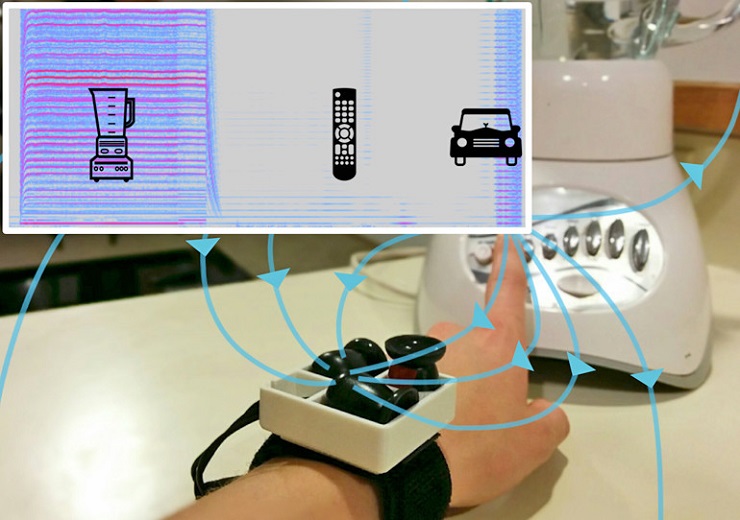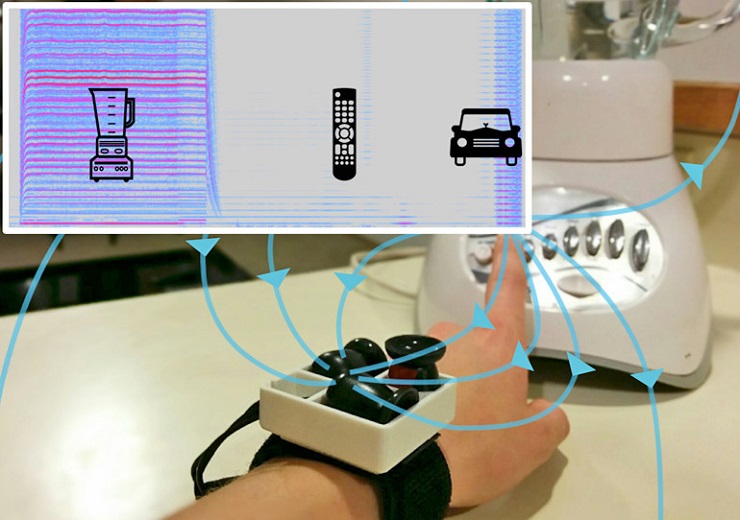A new wearable technology called MagnifiSense can sense what devices the user interacts with throughout the day, enabling tracking of carbon footprints, and smart home applications. The system can also differentiate between electromagnetic radiation from the combinations of electronic components such as motors, rectifiers, and modulators embedded in everyday devices such as blenders and hair dryers, which they claim emit different ‘songs’.
“When a blender turns on, for instance, modulators change the current profile of the device and create something similar to a vocal cord pattern,” lead author Edward Wang, an electrical engineering doctoral student explained. “A blender ‘sings’ quite differently than a hair dryer even though to our ears they sound similar.”
In a paper presented last week at the 2015 ACM International Joint Conference on Pervasive and Ubiquitous Computing, the MagnifiSense prototype correctly classified 94% of users’ interactions with 12 common devices after a quick one-time calibration, including microwaves, blenders, remote controls, electric toothbrushes, laptops, light dimmers, and even cars and buses.
The sensor, worn on the wrist, uses unique electromagnetic radiation signatures generated by electrical components or motors in those devices to pinpoint when its wearer flicks a light switch, turns on a stove, or even boards a train.
The team also developed innovative signal processing and machine learning algorithms to help the system correctly match those patterns with a particular type of device.
One advantage to a wearable option is that anyone concerned about privacy issues can control when they use it, researchers say, or simply take it off.
“It’s another way to log what you’re interacting with so at the end of the day or month you can see how much energy you used,” University of Washington Ubicomp Lab professor of computer science and engineering and electrical engineering, Shwetak Patel explained, “Right now, we can know that lights are 20% of your energy use. With this, we divvy it up and say who consumed that energy.”
MagnifiSense also has potential for other smart home applications, such as recognizing a user’s preference for interacting with an appliance or device. By sensing whether an adult or child is turning on a television or tablet, for instance, a system could automatically display their favorite programs or tailor the device with appropriate selections.
According to lead author Edward Wang, an electrical engineering doctoral student, “The nice thing with MagnifiSense is that you don’t have to instrument every single appliance in your house, which gets expensive and cumbersome. It can also sense some of the blank spots that other technologies can’t, like battery-powered devices.”
The team combined three simple, off-the-shelf sensors that use inductors, or coils of wire wound around magnets. Those proved to be the most accurate without being so power-hungry that wearing them would be impractical.
Making it smaller
Next steps include testing MagnifiSense on a wider variety of devices and distinguishing between multiple devices operating in close proximity. In preliminary tests, for instance, MagnifiSense had the most trouble correctly classifying a handful of particular toothbrushes, shavers, and cars.
The researchers also plan to work on miniaturizing their proof-of-concept device into something that could be embedded into a watch or band. Based on its investigation, the team believes that with slight improvement to the update rate of magnetic sensors in current smartphones and smartwatches, MagnifiSense could soon be enabled on new devices with a simple software upgrade.
“We think it could be integrated into any wrist-sized product,” Patel said. “The next steps are really to look at what other devices we can detect and work on a prototype that’s wearable.”


